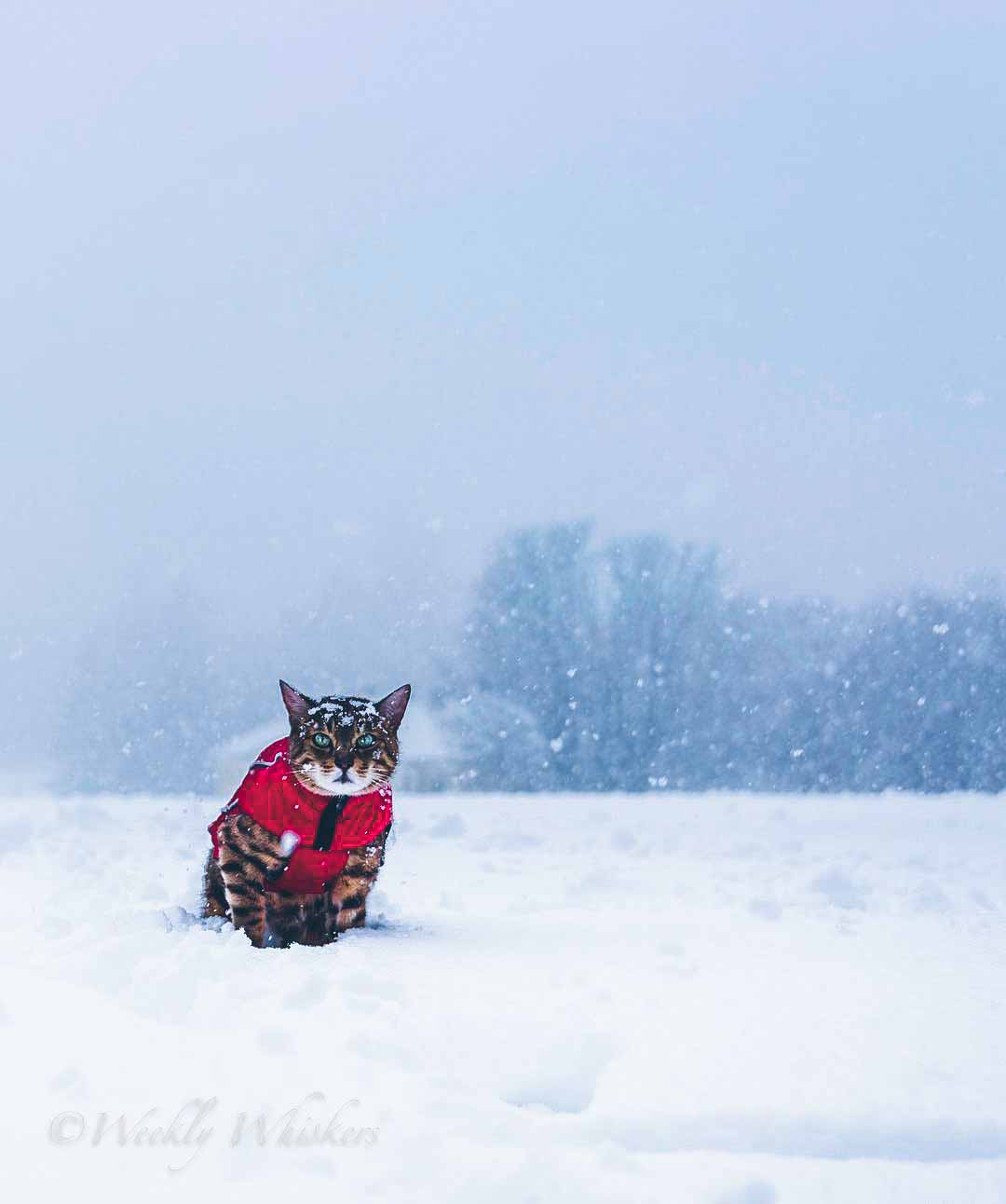- Sustainable Tails
- Posts
- Sustainable Tails
Sustainable Tails
Can Cats Hear Ultrasonic Sound, Keeping Cats Safe During Cold Weather, and Joey
Hello gang and welcome back to this week’s edition of Sustainable Tails! We are happy to have you along on our journey. This is always fun to put together and we enjoy coming up with an array of topics to share with you. The usual features you have come to know and love are still here, so just kick back and enjoy what we have put together for you!
Cats Can Hear Ultrasonic Noises?

Cats' exceptional ability to hear ultrasonic noises serves as a remarkable adaptation, particularly in relation to their role as natural predators, especially when it comes to dealing with rodents. Rodents, such as mice and rats, often communicate using ultrasonic frequencies that are beyond the range of human hearing. Cats, on the other hand, possess highly sensitive ears that can detect these high-pitched sounds, providing them with a unique advantage in hunting and pest control.
The ability to hear ultrasonic frequencies allows cats to pinpoint the location and movement of rodents with extraordinary precision. This heightened sense of hearing enhances their efficiency as hunters, making it difficult for rodents to remain undetected. Cats can interpret these ultrasonic cues to gauge the size, location, and even the health of their potential prey.
This natural skill not only makes cats formidable hunters but also positions them as effective deterrents in controlling rodent populations. In households or environments prone to rodent infestations, having a cat can act as a proactive and eco-friendly method of pest management, reducing the reliance on chemical solutions. Overall, the feline capability to detect ultrasonic noises showcases the intricate ways in which their senses have evolved for survival and coexistence with humans.
Cat Fact Corner
Grapes and raisins, as well as onions, garlic, and chives, are all extremely harmful foods for cats. Grapes and raisins can cause kidney failure — although the reasoning behind that isn’t clear. Meanwhile, onions, garlic, and chives wreak havoc on your cat’s gastrointestinal system and can cause anemia.
Keeping Cats Safe During Cold Weather

Ensuring the safety of pet cats during cold weather is paramount for their well-being. Cats are susceptible to the cold, and taking preventive measures is crucial.
Firstly, provide a warm and sheltered environment indoors, as cats can suffer from hypothermia in freezing temperatures. If outdoor access is necessary, furnish a cozy shelter with insulated bedding and a flap to shield from wind. Monitor your cat's paws, as ice and snow can accumulate between their paw pads. Wipe their feet after outdoor excursions to prevent discomfort or injury. Invest in cat-friendly booties for additional protection.
Keep your cat well-fed, as outdoor cats may require extra calories in colder weather to maintain body temperature. Ensure a constant supply of fresh, unfrozen water, as hydration is vital for overall health. Grooming is essential. Brush your cat regularly to remove excess fur, preventing matting and promoting better insulation. However, avoid shaving or trimming their coat too short during winter.
Finally, be cautious of toxic substances like antifreeze, which can be lethal if ingested. Wipe down your cat's paws and fur to eliminate any residue after outdoor walks, and store antifreeze out of reach.
By implementing these precautions, pet owners can create a safe and warm environment for their feline companions, ensuring their health and happiness during colder months.
Pet Poem Place
By Haley, Age 9, California USA
She is so sweet,
She is so kind,
She learns her manners,
She learns to mind.
I care for her,
In many ways,
Feed, Walk, Play, Teach,
Fills my days!
Our “Cookie” makes
our life so fun,
She takes a lot of work
But gives cuddles when it’s done!
Pet Of The Week - Joey
Joey was born without his front legs. He was the only pup in his litter who wasn’t adopted, but that certainly did not keep him from accomplishing something pretty incredible. He made it to the Big Stage by appearing in the Puppy Bowl XIX in 2023 playing for Team Ruff.
Vintage Pet Rescue came across Joey after the Connecticut Humane Society reached out to them. Vintage Pet Rescue typically rescues older pets, but occasionally rescues much younger pets with special needs. Joey fit this bill. His owner, Cathy Larson, noticed Joey from a Facebook post and “instantly fell in love with him.”
Joey is adventurous, loves to meet new people, and he loves snuggles. With a lot of love, affection, and determination, no matter what species we are, we can accomplish some pretty amazing things.
The outcome of Puppy Bowl XIX was Team Fluff beating Team Ruff by a score of 87-83, but it was still a fun day to be had by all. Congratulations to Joey for finding a loving home and having a fun and exciting life.
Can An Older Dog Be Taught New Tricks?

Absolutely, it is possible to teach old dogs new tricks! While the popular saying suggests otherwise, older dogs are quite capable of learning and adapting. The key lies in understanding their individual needs, motivations, and using positive reinforcement.
Older dogs may require a bit more patience and a gentle approach compared to younger counterparts. Their learning pace might be slower, but with consistency and positive reinforcement, they can grasp new commands and tricks. Keep training sessions short, enjoyable, and tailored to their abilities.
Understanding the dog's physical condition is essential. Some older dogs may have mobility issues, so choose tricks that are comfortable for them. Use high-value treats and praise to motivate and reward their efforts.
Building on established commands is a great way to introduce new tricks. For example, if a dog knows "sit," you can progress to "sit pretty" or "shake." This builds on their existing knowledge, making the learning process smoother.
In essence, while older dogs may have established habits, they are never too old to learn. The key is adapting training methods to suit their pace, using positive reinforcement, and creating a supportive environment that encourages them to enjoy the learning process. With the right approach, older dogs can surprise their owners with new tricks and continue to engage mentally and physically throughout their lives.
Just For Fun
Well, that’s a wrap for this week. Please be sure to share this growing community of pet lovers from around the world with your friends and family. We send you an unobtrusive email once a week right to your mailbox. That’s all there is to it! We welcome any and all input from all of our subscribers. Send us topics you’d love to know more about, or just drop a line to say hello. There are exciting things coming as Sustainable Tails grows in popularity!
Sustainable Tails is dedicated to helping you create a harmonious and eco-friendly life for you and your pets. By embracing zero-waste and pet-friendly grooming products and sustainably exploring the outdoors together, you're not only enhancing the well-being of your furry companions but also contributing to a healthier planet.
Thank you for joining us on this weeks adventure. Continue to spread the word on what we are doing here, and always know your comments and participation in our community are welcomed with open paws. We’ll see you right here next week, so continue making sustainable choices and cherishing each and every day with your beloved pets!
Joshua McCarty
Founder, Sustainable Tails
P.S. Have a topic you’d like us to cover in our next newsletter? Share your ideas and questions with us. We’d love to hear from you!
P.P.S. Take a peek over at our partner website for an ever growing list of sustainable and eco-friendly pet supplies and accessories, as well as many other pet friendly products!





:max_bytes(150000):strip_icc()/290951532_10224308120263948_7732299510661852544_n-e54b758108b74febb65d3c219c0983c6.jpg)